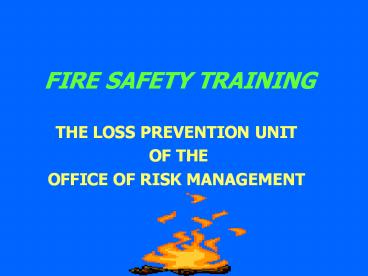FIRE SAFETY TRAINING - PowerPoint PPT Presentation
Title:
FIRE SAFETY TRAINING
Description:
fire safety training the loss prevention unit of the office of risk management course outline fire science fire science fire science fire science fire science fire ... – PowerPoint PPT presentation
Number of Views:21834
Avg rating:3.0/5.0
Title: FIRE SAFETY TRAINING
1
FIRE SAFETY TRAINING
- THE LOSS PREVENTION UNIT
- OF THE
- OFFICE OF RISK MANAGEMENT
2
COURSE OUTLINE
I. FIRE SCIENCE II. FIRE SAFETY INSPECTIONS
III. EVACUATION PLAN IV. FIRE EXTINGUISHERS
V. OTHER FEATURES OF FIRE PROTECTION
3
FIRE SCIENCE
4
FIRE SCIENCE
What elements are needed to start a fire?
5
FIRE SCIENCE
The Fire Tetrahedron
6
FIRE SCIENCE
FUEL CAN BE
- LIQUID Grease, Oil, Fuel
- SOLID Wood, Paper, Metal
- GAS Natural Gas, Propane, Acetylene.
7
CLASS A FIRES - Ordinary combustibles such
as wood, paper, cloth.
8
CLASS B FIRES - Flammable liquids such as oil,
grease
9
CLASS C FIRES - Energized electrical
equipment
10
CLASS D FIRES - Flammable Metals
11
FIRE SCIENCE
What is smoke?
12
FIRE SCIENCE
WHAT IS THE DIFFERENCE BETWEEN COMBUSTIBLE AND
FLAMMABLE MATERIAL? Combustible material has a
flashpoint of 100 F or above Flammable material
has a flashpoint below 100 F Ref. NFPA 96
13
FIRE SCIENCE
14
FIRE SCIENCE
15
REGARDING FIREFIGHTING, MSDSs TELL YOU IMPORTANT
FACTS ABOUT THE CHEMICALS OR PRODUCTS YOU STORE!
16
FIRE SAFETY INSPECTIONS
YOUR ORM LOSS PREVENTION OFFICER
IS AVAILABLE TO ASSIST
17
FIRE SAFETY INSPECTIONS
SOME HAZARDS TO LOOK FOR IN YOUR WORKPLACE
18
EXAMPLES
- Locked or blocked exits (common hazard)
- Trash or debris Electrical hazards Cooking
hazards Chemical, Gas Cylinders/ System, and
Labs - Smoking Areas
- Exit Signs Blocked exits/isles/hallways
- Fire extinguisher hazards
- Emergency lighting hazards
- Emergency stairway doors blocked or propped open
19
FIRE SAFETY INSPECTIONS
20
FIRE SAFETY INSPECTIONS
REMEMBER
The best way to fight fire is to prevent it
21
FIRE EVACUATION PLAN
22
EVACUATION PLAN
- COMPONENTS OF AN EVACUATION PLAN
- Emergency Control Committee - develops plan
- Emergency Crews - administer plan
- Escape routes - primary secondary
- Maps - posted indicating escape routes, first
aid kits and extinguishers
23
FIRE EVACUATION PLAN
WHAT TO DO IN CASE OF FIRE
FOLLOW YOUR AGENCYS FIRE EVACUATION PLAN
24
FIRE EVACUATION PLAN
WHAT TO DO IF YOU SHOULD BECOME TRAPPED IN A
BUILDING
- Dont panic
- Try to find a secondary exit
- Feel doors for heat with your hand
- If the door is hot, dont open it!
- If you cant find another exit, stay where you
are
25
FIRE EVACUATION PLAN
- Seal doors and vents to prevent smoke
penetration. - If possible call 911 and report your exact
location. - Stay low to avoid smoke and heat.
26
EVACUATION PLAN
The plan should be reviewed and, if possible,
approved by
- Fire officials (either State or Local
officials) - Office of State Buildings.
27
EVACUATION PLAN
FIRE DRILLS
are conducted at least once each year, but some
agencies may require them more frequently.
28
EVACUATION PLAN
- FIRE DRILLS cont.
- Remember to DOCUMENT
- Date time
- Employees visitors present
- Outside meeting location
- Headcount
- Time of entire drill
29
FIRE EXTINGUISHERS
30
FIRE EXTINGUISHERS
KNOW WHERE FIRE EXTINGUISHERS ARE
LOCATED IN YOUR WORKPLACE LEARN HOW TO USE THEM
FFECTIVELY NEVER LEAVE AN EXTINGUISHED FIRE
UNATTENDED
31
FIRE EXTINGUISHERS
INSPECTIONS
- The National Fire Protection Association
(NFPA) defines an inspection as a quick check
that the extinguisher is available and will
function - NFPA requires extinguishers be inspected
monthly, or more frequently if circumstances
require it
32
FIRE EXTINGUISHERS
WHO CAN INSPECT A FIRE EXTINGUISHER
Anyone. NFPA says minimal knowledge required
33
FIRE EXTINGUISHERS
INSPECTION PROCEDURES
- Extinguisher located in designated place?
- Obstructions to access or visibility?
- Operating Instructions on nameplate legible
facing outward? - Seals tamper indicators in place intact?
34
FIRE EXTINGUISHERS
- Determine fullness by weight or by hefting.
Invert shake it will help ensure caking or
hardening of powder has not occurred. - Visually examine for obvious physical damage,
corrosion, leakage, or a clogged nozzle. - Check to see if the pressure gauge is in
operable range.
35
FIRE EXTINGUISHERS
INSPECTION TAG
36
FIRE EXTINGUISHERS
MAINTENANCE
NFPA defines maintenance as a thorough check
of the extinguisher.
37
FIRE EXTINGUISHERS
FIRE EXTINGUISHER INSPECTOR CONTRACTOR In
Louisiana, must be licensed certified by the
Office of the State Fire Marshal (OSFM) to
perform such work.
38
FIRE EXTINGUISHERS
HOW OFTEN SHOULD MAINTENANCE BE PERFORMED
The NFPA says that maintenance should be
performed at least annually
39
FIRE EXTINGUISHERS
MAINTENANCE RECORDKEEPING
- NFPA requires that a tag be attached to the
extinguisher indicating - The month year the maintenance was performed,
and - Identification of the person the company
performing the work.
40
FIRE EXTINGUISHERS
MAINTENANCE TAGS
41
FIRE EXTINGUISHERSExtinguisher Rating System
42
FIRE EXTINGUISHERS
TYPES OF EXTINGUISHERS
Carbon Dioxide (CO2)
43
FIRE EXTINGUISHERS
TYPES OF EXTINGUISHERS
Stored pressure dry powder (ABC)
44
FIRE EXTINGUISHERS
TYPES OF EXTINGUISHERS
Clean agent type extinguishers (Halon)
45
FIRE EXTINGUISHERS
SIZES
Minimum size is 2A10BC. The number indicates
the number of square feet the letter indicates
the type of fire.
46
FIRE EXTINGUISHERS
IMPORTANT TO REMEMBER
Ensure that each area has the proper type fire
extinguisher!
47
OTHER FEATURES OF FIRE PROTECTION
SPRINKLERS
48
TYPES OF CONTROL VALVES
49
OTHER FEATURES OF FIRE PROTECTION
ALARMS
50
OTHER FEATURES OF FIRE PROTECTION
DETECTORS STOBES
51
OTHER FEATURES OF FIRE PROTECTION
FIRE DOORS
52
OTHER FEATURES OF FIRE PROTECTION
SUPPRESSION SYSTEMS
53
THE END!
- THANK YOU FOR ATTENDING!































